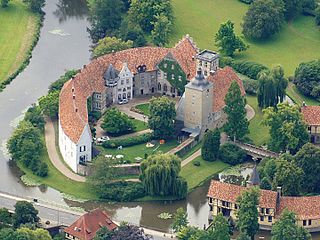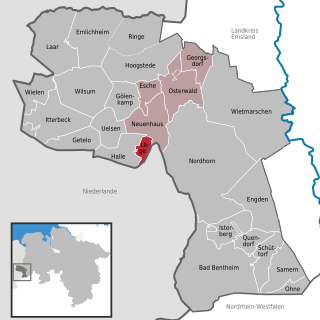
Bentheim Castle (German : Burg Bentheim) is an early medieval hill castle in Bad Bentheim, Lower Saxony, Germany. The castle is first mentioned in the 11th century under the name binithem.

Bentheim Castle (German : Burg Bentheim) is an early medieval hill castle in Bad Bentheim, Lower Saxony, Germany. The castle is first mentioned in the 11th century under the name binithem.
The castle is built on a protrusion of Bentheim sandstone, which not only provided building materials for the castle itself but was also a valued export product. [1] This Bentheimer Höhenrücken is the last protrusion of the nearby Teutoburger forest. [2] Its elevated position in an otherwise very flat landscape provides an excellent view and thus a strategic location to build a castle.


The earliest history of the castle, which was erected on the remains of an earlier refuge castle is largely unknown. [3] In the registries of Werden Abbey (1050) the castle is mentioned, as Binedheim, in and contributes grain, honey and 2 solidi. [4] A document from 1020 names Otto von Northeim as the owner of the castle. [4] In 1116, the castle is completely destroyed in the war between Herzog Lothar von Süpplinburg, better known as Lothar III and Heinrich V. [5] The Annalista Saxo describes how Lothar "lays siege to Binithem, a fine and strong city and burned it after it was conquered". [5] The epithet "strong" (firmam) suggests the castle played a vital role in the cities defences, though it is assumed it was a wooden structure, and not yet a stone one.
The castle is soon rebuilt and this time in stone by Otto von Salm, brother in law of the victorious Lothar III, whose wife Gertrud von Northeim uses it as a residence. In 1050 she is mentioned as comitissa de Benetheim, which is the first documented member of the Counts of Bentheim. [4]
In 1146 a war erupted between Otto von Rheineck and the Bishop of Utrecht concerning the jurisdiction over Twente and Otto and his knights were defeated near Ootmarsum and the castle became a fee of the Diocese of Utrecht and the Bishop claimed the palace and the chapel for his personal use until 1190. Otto's son and only heir, Otto II von Salm-Rheineck tried to recapture the castle but fell into the hands of Hermann von Stahleck in 1148. He spent some time as a prisoner in Schönburg near Oberwesel and was strangled the next year. To the bishops of Münster and Utrecht the independent county remained a thorn in the side, and most notably in 1374 both launched attacks upon the castle. [4]
Otto's daughter, Sophie von Salm-Rheineck inherited the castle. She married Dirk VI, Count of Holland and the castle (1154) and the county (1165) thus passed into the hands of the Counts of Holland. Their son, Otto the Younger is mentioned in a deed by Henry the Lion as comes de Binitheim. He is the first of the counts of Bentheim-Holland, whose rule lasts until 1421 when the castle passes into the hands of Eberwin IV von Götterswick, a cousin of the last count of Bentheim-Holland. [4]

From 1421 the name Grafen von Bentheim first appears. In 1486 Graf Eberwin II gets a Fee from Frederick III and the County of Bentheim becomes an independent political entity. In 1489 this is reflected in the Burg, and the construction of the Pulverturm starts Between 1588 and 1593, Arnold II chooses the side of the Reformation, following the church reformers Calvin and Zwingli. During the Thirty Years' War, the county pays the price for its choice and is repeatedly sacked by Spanish troops. Much of the castle is destroyed in the process. This is repeated during the Seven Years' War, in which the Burg repeatedly comes under siege from French and British troops and is taken several times. In 1795 it served as a field hospital in the war against the revolutionary French Army and was set ablaze and taken by general Dominique Vandamme. 52°18′09″N7°09′23″E / 52.3025°N 7.1563°E
The castle is still owned by the Prince of Bentheim-Steinfurt who is living at Steinfurt Castle. It is home to some of his siblings and is also open to the public as a family museum.

Steinfurt is a city in North Rhine-Westphalia, Germany. It is the capital of the district of Steinfurt. From c. 1100–1806, it was the capital of the County of Steinfurt.
Floris III was the count of Holland from 1157 to 1190. He was a son of Dirk VI and Sophia of Rheineck, heiress of Bentheim.

Bad Bentheim is a town in the southwestern part of Lower Saxony, Germany, in the district of Grafschaft Bentheim on the borders of North Rhine-Westphalia and the Netherlands roughly 15 km south of Nordhorn and 20 km northeast of Enschede. It is a state-recognized thermal brine and sulphur spa town, hence the designation Bad (“Bath”). Also to be found in Bad Bentheim is the castle Burg Bentheim, the town's emblem.
Bentheim-Bentheim was a county in southeastern Lower Saxony, Germany, the borders of which by 1806 were the modern borders of the District of Bentheim. This county was formed from the county of Bentheim in 1277, and from it was formed Bentheim-Steinfurt in 1544. Bentheim-Bentheim reemerged as a county in 1643 and was mediatised to Berg in 1806, before being annexed to France in 1810. It was granted to Hanover by the Congress of Vienna.
Bentheim-Steinfurt was a historical county located in northwestern North Rhine-Westphalia in the region surrounding Steinfurt, Germany. Bentheim-Steinfurt was a partition of Bentheim-Bentheim, itself a partition of the County of Bentheim. Bentheim-Steinfurt was partitioned: between itself and Bentheim-Tecklenburg-Rheda in 1606; and between itself and Bentheim-Bentheim in 1643.

The County of Bentheim was a state of the Holy Roman Empire, located in the south-west corner of today's Lower Saxony, Germany. The county's borders corresponded largely to those of the modern administrative district (Landkreis) of Grafschaft Bentheim.
Dirk VI was Count of Holland between 1121 and 1157, at first, during his minority, under the regency of his mother Petronilla. He was the son of Count Floris II. After his death he was succeeded by his eldest son Floris III. He married Sofie of Salm, Countess of Rheineck and Bentheim. She was heiress of Bentheim, which she ruled together with her husband and which was inherited by the couple's second son Otto after his parents' death.

Uelsen is a community in the district of Grafschaft Bentheim in Lower Saxony.

Lage is a community on the river Dinkel in the district of Grafschaft Bentheim in Lower Saxony with roughly 1,000 inhabitants. It belongs to the Joint Community (Samtgemeinde) of Neuenhaus.
Henry the Fat, also known as Henry of Nordheim or Northeim, was Count in Rittigau and Eichsfeld from 1083 onwards, and was the Margrave of Frisia from 14 April 1099 until he was murdered in 1101. He was the father of Empress Richenza.
Baldwin van Holland was a bishop of Utrecht from 1178 to 1196
Eric V of Hoya was from 1563 to 1575 Count of Hoya.
Otto VIII, Count of Hoya was the last ruling Count of Hoya.

Arnold III of Bentheim-Tecklenburg-Steinfurt-Limburg was a German nobleman. He was Count of Bentheim, Tecklenburg and Steinfurt, and jure uxoris Count of Limburg. He ruled as Arnold IV in Bentheim and Tecklenburg, and as Arnold II in Steinfurt. In Limburg, he was the first Count named Arnold and hence just the name distinctive.
Sophia of Rheineck, also known as Sophie of Salm, Countess of Bentheim was a ruling suo jure Countess of Bentheim between 1150 and 1176. She was also countess consort of Holland by marriage to Dirk VI, Count of Holland, who was her co-ruler jure uxoris in the County of Bentheim.
Otto I, Count of Salm was a German nobleman. He was a ruling count of Salm and from 1125 to 1137, he was co-ruler of the County Palatine of the Rhine with his stepson William.

Eberwin III, Count of Bentheim-Steinfurt was a German nobleman. He was a member of the elder line of the House of Bentheim-Steinfurt and was the ruling Count of Bentheim and Steinfurt from 1544 until his death. From 1557, he was also Count of Tecklenburg and Lord of Rheda by marriage.
Gertrude of Northeim, was a German noblewoman and regent.

The House of Bentheim is one of the oldest extant German noble families. They are a mediatized family, formerly being rulers of their own territories directly under the Holy Roman Emperor. They belong to both the ancient nobility (Uradel) and the high nobility (Hochadel). Today, there are two main lines of the family: the princes of Bentheim-Steinfurt and the princes of Bentheim-Tecklenburg. There is also a third, non-princely line of the family, the counts of Bentheim-Tecklenburg-Rheda.

The County of Steinfurt, originally the Lordship of Steinfurt, was a historic territory of the Holy Roman Empire in the Munsterland. It existed from roughly 1100 until 1806.